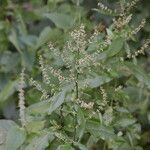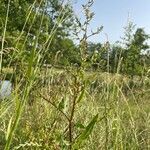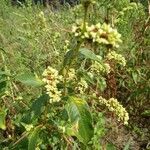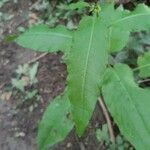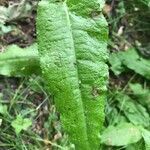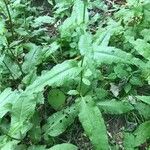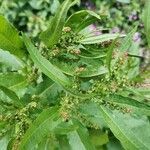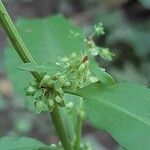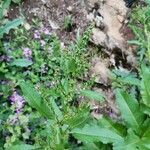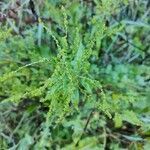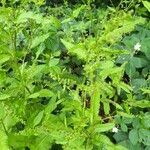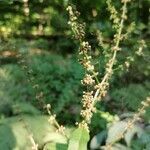Glabrous, short-lived, tap-rooted perennial; stems rather thin, wiry, flexuous, spreading, green to dark red, to c. 1 m tall. Petioles of basal lvs often very long, particularly in subaquatic plants. Lamina of lower lvs (3)-7-20-(23) × (1)-1.5-3.5 cm, oblong or ovate-oblong, ± membranous; margin often undulate and crisped; base broad-cuneate, rounded or cordate; apex acute or subacute. Stem lvs progressively smaller and extending c. ⅔ along infl. branches. Infl. many-branched, spreading and flexuous, becoming twisted. Whorls all distant; fls probably protandrous, ☿, small, dense. Pedicels slender, reddish. Perianth (0.7)-1-5 mm long; outer segments ovate, obtuse, not reflexing at fruiting; inner segments greatly enlarging at fruiting. Fruiting valves 2-2.8-(3.2) mm long, ovate, reticulate, entire, rounded at apex, generally becoming dark red, each with a large tubercle occupying ?-3/4 valve width. Nut 1.5-2 mm long, dark glossy brown or reddish brown, acutely angled.
Perennial herb, 0.2-1.0 m high; ± erect, branching below middle, branches arcuate-divaricate. Leaves: petioles of basal leaves as long as lamina; lamina narrowly oblong-ovate up to 60 x 13 mm, apex obtuse; cauline leaves becoming gradually smaller. Inflorescences open with divaricate branches, flower whorls distant, nearly all subtended by a leaf. Flowers in many-flowered whorls. Flowering time Jan.-Mar.? Fruiting pedicels ± same length as valves, articulate ± at middle or just below. Fruiting valves oblong-ovate, entire, callosity large, sometimes occupying almost whole surface of valve. Fruit a dark brown nut, up to 1.7 mm long.
Slender, glabrous, taprooted perennial to 1 m, mostly single-stemmed, lower lvs cordate or subcordate at base; panicle forming as much as half the shoot, its branches long and often divergent, the middle and lower fascicles of fls usually subtended by lvs; pedicels 1–2 mm, jointed near the base; valves oblong-ovate, 2–3 mm, 1 mm wide, the margins entire or rarely denticulate, not projecting as wings; grains commonly 3, at maturity nearly as wide as the valve; 2n=20. Native of Europe, naturalized in waste places here and there in our range.
A herb which keeps growing from year to year. It grows about 50 cm high. It branches in the lower half. The branches spread at 30°-90°. The leaf stalks of the lower leaves are as long as the blade. These lower leaves are narrowly oval and 10-25 cm long by 2.5-3.5 cm wide. The leaves get more narrow up the plant and the base becomes heart shaped. The flower is branched and has many flowers in rings. There are small leaves around the lower flowers. The fruit has oblong narrow valves with rounded ends. The nut is 1.5-2 mm long and dark brown.
Perennial herb, up to 0.8 m high. Stems erect. Leaves petiolate; blade narrowly oblong, up to 160 x 50 mm, base cordate or truncate, apex acute. Ocrea brown, membranous, usually caducous. Flowers: inflorescence an open panicle with flower whorls subtended by a leaf; callosity large, covering large part of inner perianth segments; perianth white or greenish; Nov.-Jan.
Perennial herb, up to 0.8 m high. Inflorescence an open panicle with flower whorls subtented by a leaf. Callosity large, covering large part of perianth segment. Flowers white or greenish.
